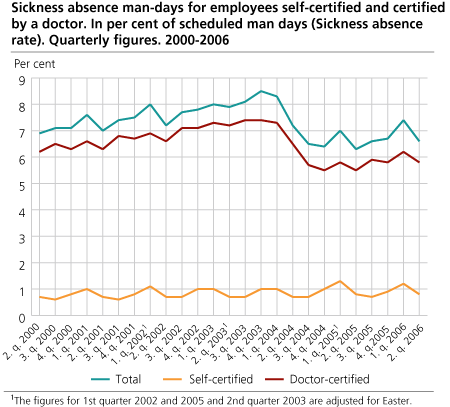Content
Published:
This is an archived release.
Increased sickness absence from 2005
The sickness absence increased from 6.3 per cent in the second quarter of 2005 to 6.6 per cent in the second quarter of 2006. Absence certified by a doctor increased from 5.5 to 5.8 per cent, and the self-certified absence stayed at 0.8 per cent.
The rise of the sickness absence from 6.3 to 6.6 per cent, corresponds to an increase of 5.3 per cent. For men the increase was 4.5 per cent and for women 5.9 per cent.
The sickness absence was 5.1 per cent lower than it was in the second quarter of 2001, the year when the agreement on an inclusive labour market was implemented.
If we took into account that the Easter week occurred in the second quarter of 2006 and in the first quarter of 2005, we roughly estimate that the growth in sickness absence rate would have been 3.7 per cent from the second quarter 2005 to the second quarter 2006. This is approximately on the same level as for the growth from the first quarter 2005 to the first quarter 2006.
In the rest of the article we do not take the Easter week into consideration.
Increase in most industries
The growth in sickness absence was largest in education with an increase of 7.3 per cent and in public administration with 6.6 per cent. Amongst the larger industries, domestic trade, hotels and restaurants had the lowest increase with 4.0 per cent.
Increase in all counties
The sickness absence grew in all counties from the second quarter of 2005 to the second quarter of 2006. Hedmark had the largest increase with 10.1 per cent increase followed by Telemark with 8.9 percent. The counties having smallest growth were Aust-Agder with 1.0 per cent increase and Sør-Trøndelag with 1.9 per cent increase.
The sickness absence level was still highest in Finnmark with 8.9 per cent and lowest in Rogaland with 5.2 per cent.
Rise in the proportion of long-lasting absences
Sickness absence lasting more than 31 days within the quarter, added up to 63.5 per cent of the sickness absence in the second quarter of 2006. This was an increase from 61.0 per cent in the second quarter of 2005.
The proportion of self-certified sickness absence compared to the total sickness absence (self-certified and doctor-certified) dropped from 12.7 per cent to 11.6 per cent during the same period.
Strongest increase in Central Government
The sickness absence increased in all sectors. The strongest growth was in Central Government including the state hospitals with 7.6 per cent. Within this sector, the sickness absence increased by 10.7 per cent in education (universities and colleges). Within health-care (mainly the state hospitals) the sickness absence increased by 7.1 per cent.
In local government, the sickness absence rose by 6.5 per cent. Within this sector, the sickness absence grew by 6.7 in education (primary and high schools).
Within private sector and public enterprises the sickness absence increased by 4.5 per cent. Amongst the larger industries within this sector, mining and quarrying had the largest growth by 6.0 per cent.
The following results are based on data on sickness absence certified by a doctor, as the survey on self-certified absence does not contain data on sickness absence by age.
Rise in all age groups
The sickness absence grew in all age groups and for both sexes between 16 and 66 years. The strongest increase was found in the age group 55-59 years, which had an increase by 8.1 per cent. The weakest growth was in the group 20-24 years with an increase by 3.5 per cent.
The sickness absence increased in all age groups, with the exception of males aged 20-24 years. The strongest increase is found among females between 40 and 60 years old where the sickness absence increased by more than 10 per cent.
The sickness absence rate measures the proportion of scheduled man-days lost due to own sickness. The statistics do not cover self-employed persons.
Tables:
- Table 1 Sickness absence man-days for employees self-certified and certified by a doctor. In per cent of scheduled man-days (Sickness absence rate). Quarterly figures. 2000-2006
- Table 2 Sickness absence man-days for employees self-certified and certified by a doctor, by sex. In per cent of scheduled man-days (Sickness absence rate). Quarterly figures. 2000-2006
- Table 3 Sickness absence man-days for employees self-certified and certified by a doctor, by industry and type of sickness absence. In per cent of scheduled man days (Sickness absence rate). Quarterly figures. 2000-2006
Contact
-
Arbeidsmarked og lønn
E-mail: arbeidsmarked@ssb.no
-
Unn H. Høydahl
E-mail: unnh.hoydahl@ssb.no
tel.: (+47) 40 90 23 77

